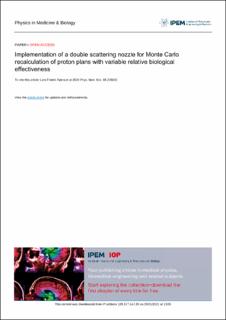| dc.contributor.author | Fjæra, Lars Fredrik | |
| dc.contributor.author | Indelicato, Daniel J. | |
| dc.contributor.author | Stokkevåg, Camilla Hanquist | |
| dc.contributor.author | Muren, Ludvig Paul | |
| dc.contributor.author | Hsi, Wen C. | |
| dc.contributor.author | Ytre-Hauge, Kristian | |
| dc.date.accessioned | 2021-06-07T12:29:30Z | |
| dc.date.available | 2021-06-07T12:29:30Z | |
| dc.date.created | 2021-01-21T13:36:03Z | |
| dc.date.issued | 2020 | |
| dc.Published | Physics in Medicine and Biology. 2020, 65:225033 (22), 1-20. | |
| dc.identifier.issn | 0031-9155 | |
| dc.identifier.uri | https://hdl.handle.net/11250/2758215 | |
| dc.description.abstract | A constant relative biological effectiveness (RBE) of 1.1 is currently used in clinical proton therapy. However, the RBE varies with factors such as dose level, linear energy transfer (LET) and tissue type. Multiple RBE models have been developed to account for this biological variation. To enable recalculation of patients treated with double scattering (DS) proton therapy, including LET and variable RBE, we implemented and commissioned a Monte Carlo (MC) model of a DS treatment nozzle. The main components from the IBA nozzle were implemented in the FLUKA MC code. We calibrated and verified the following entities to experimental measurements: range of pristine Bragg peaks (PBPs) and spread-out Bragg peaks (SOBPs), energy spread, lateral profiles, compensator range degradation, and absolute dose. We recalculated two patients with different field setups, comparing FLUKA vs. treatment planning system (TPS) dose, also obtaining LET and variable RBE doses. We achieved good agreement between FLUKA and measurements. The range differences between FLUKA and measurements were for the PBPs within ±0.9 mm (83% ≤ 0.5 mm), and for SOBPs ±1.6 mm (82% ≤ 0.5 mm). The differences in modulation widths were below 5 mm (79% ≤ 2 mm). The differences in the distal dose fall off (D80%–D20%) were below 0.5 mm for all PBPs and the lateral penumbras diverged from measurements by less than 1 mm. The mean dose difference (RBE = 1.1) in the target between the TPS and FLUKA were below 0.4% in a three-field plan and below 1.4% in a four-field plan. A dose increase of 9.9% and 7.2% occurred when using variable RBE for the two patients, respectively. We presented a method to recalculate DS proton plans in the FLUKA MC code. The implementation was used to obtain LET and variable RBE dose and can be used for investigating variable RBE for previously treated patients. | en_US |
| dc.language.iso | eng | en_US |
| dc.publisher | IOP Publishing | en_US |
| dc.rights | Navngivelse 4.0 Internasjonal | * |
| dc.rights.uri | http://creativecommons.org/licenses/by/4.0/deed.no | * |
| dc.title | Implementation of a double scattering nozzle for Monte Carlo recalculation of proton plans with variable relative biological effectiveness | en_US |
| dc.type | Journal article | en_US |
| dc.type | Peer reviewed | en_US |
| dc.description.version | publishedVersion | en_US |
| dc.rights.holder | Copyright 2020 Institute of Physics and Engineering in Medicine | en_US |
| dc.source.articlenumber | 225033 | en_US |
| cristin.ispublished | true | |
| cristin.fulltext | original | |
| cristin.qualitycode | 1 | |
| dc.identifier.doi | 10.1088/1361-6560/abc12d | |
| dc.identifier.cristin | 1876585 | |
| dc.source.journal | Physics in Medicine and Biology | en_US |
| dc.source.40 | 65:225033 | |
| dc.source.14 | 22 | |
| dc.identifier.citation | Physics in Medicine and Biology. 2020, 65 (22), 225033. | en_US |
| dc.source.volume | 65 | en_US |
| dc.source.issue | 22 | en_US |

